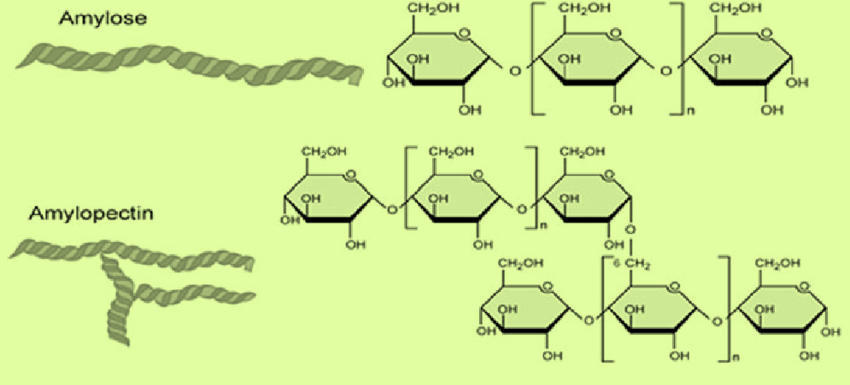
Write the name of the fraction that constitutes $80\% $ of starch and is water insoluble.
Answer
571.8k+ views
Hint: Starch is one of the most important dietary sources for human beings. It consists of numerous glucose units joined together by glycosidic bonds. It is basically classified into two types based on the basis of structure i.e. linear and helical amylose and branched amylopectin.
Complete step by step answer:
-Starch is a white, granular organic chemical that is produced by all green plants. It is basically a soft, white and tasteless powder that is insoluble in cold water, alcohol and many other solvents. The basic chemical formula of the starch molecule is ${({C_6}{H_{10}}{O_5})_n}$. Basically, it is a polymer of glucose monomers that are linked with each other to form a polysaccharide.
Starch is composed of two types of polysaccharide molecules:
Amylose
Amylopectin $(80\% )$
Now, let’s discuss both the types in detail.
-The first one is Amylose. It is basically a polysaccharide made up of several D-glucose units. When iodine is added to starch, the colour changes to dark blue or black. This is due to the presence of amylose in starch. It is soluble in water and can be further hydrolyzed into glucose units by enzymes such as $\alpha - $ amylase and $\beta - $ amylase.
Now, the second one is amylopectin. It is a polymer of several D-glucose molecules. $80\% $ of amylopectin is present in starch. Moreover, when iodine is added to the starch, it gives reddish-brown appearance. This is due to the presence of amylopectin in the starch.
Both the structures are as shown:

Hence, Amylopectin constitutes $80\% $ of starch and is water insoluble.
Note:
Starch is used in bakery products such as cakes, biscuits etc. It is also used in detergents, in the production of dry sausages, salamis and also in some of the alcoholic beverages. Moreover, in industries, it is used to resist the moisture penetration.
Complete step by step answer:
-Starch is a white, granular organic chemical that is produced by all green plants. It is basically a soft, white and tasteless powder that is insoluble in cold water, alcohol and many other solvents. The basic chemical formula of the starch molecule is ${({C_6}{H_{10}}{O_5})_n}$. Basically, it is a polymer of glucose monomers that are linked with each other to form a polysaccharide.
Starch is composed of two types of polysaccharide molecules:
Amylose
Amylopectin $(80\% )$
Now, let’s discuss both the types in detail.
-The first one is Amylose. It is basically a polysaccharide made up of several D-glucose units. When iodine is added to starch, the colour changes to dark blue or black. This is due to the presence of amylose in starch. It is soluble in water and can be further hydrolyzed into glucose units by enzymes such as $\alpha - $ amylase and $\beta - $ amylase.
Now, the second one is amylopectin. It is a polymer of several D-glucose molecules. $80\% $ of amylopectin is present in starch. Moreover, when iodine is added to the starch, it gives reddish-brown appearance. This is due to the presence of amylopectin in the starch.
Both the structures are as shown:

Hence, Amylopectin constitutes $80\% $ of starch and is water insoluble.
Note:
Starch is used in bakery products such as cakes, biscuits etc. It is also used in detergents, in the production of dry sausages, salamis and also in some of the alcoholic beverages. Moreover, in industries, it is used to resist the moisture penetration.
Recently Updated Pages
Master Class 12 English: Engaging Questions & Answers for Success

Master Class 12 Business Studies: Engaging Questions & Answers for Success

Master Class 12 Economics: Engaging Questions & Answers for Success

Master Class 12 Social Science: Engaging Questions & Answers for Success

Master Class 12 Maths: Engaging Questions & Answers for Success

Master Class 12 Chemistry: Engaging Questions & Answers for Success

Trending doubts
What are the major means of transport Explain each class 12 social science CBSE

Differentiate between homogeneous and heterogeneous class 12 chemistry CBSE

Draw a ray diagram of compound microscope when the class 12 physics CBSE

How is democracy better than other forms of government class 12 social science CBSE

What is virtual and erect image ?

Explain the energy losses in the transformer How are class 12 physics CBSE




